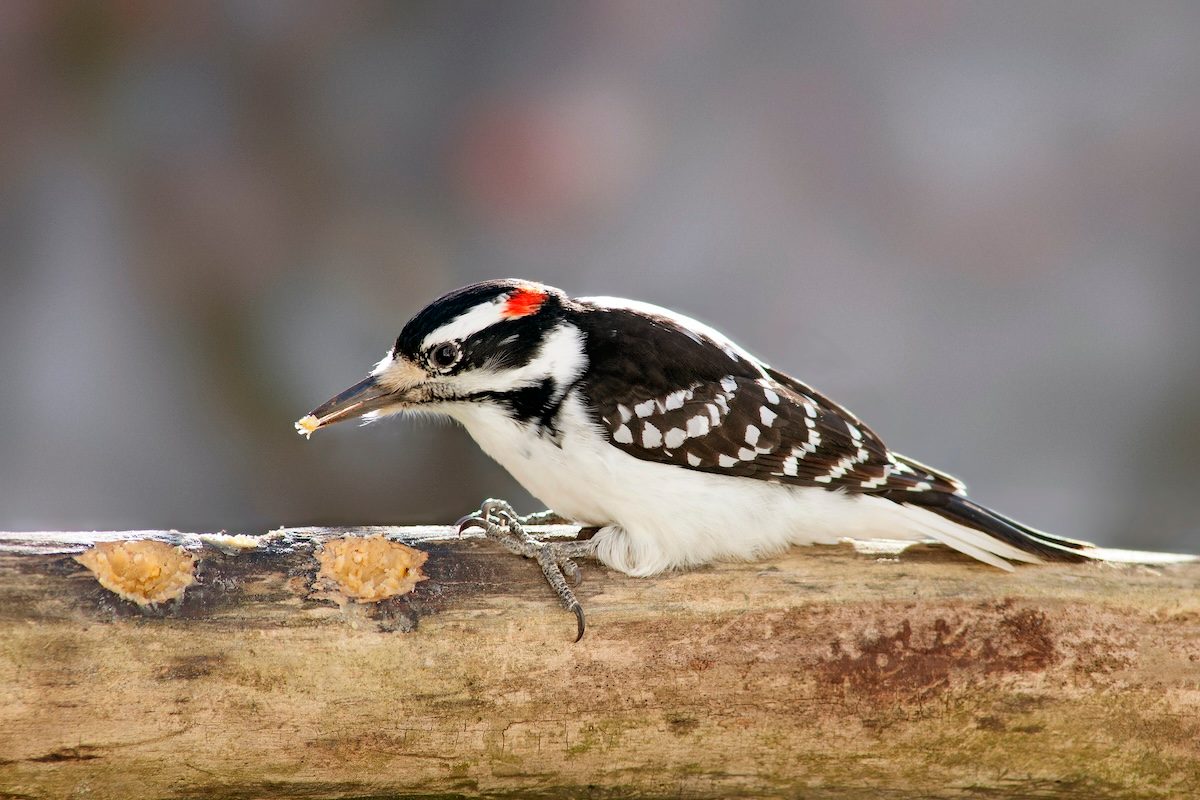A hairy woodpecker brings flashes of black and white to your backyard. Attract these birds with suet and peanut feeders.

How to Identify a Hairy Woodpecker

Attracting a hairy woodpecker to your yard can be a challenge compared to its more common look-alike, the downy woodpecker, but the bright, bold beauties are found across the continent and worth looking for.
On This Page
What Does a Hairy Woodpecker Look Like?

“Its head is a collage of black slits near the eye, with black on the crown,” says Keith Arnold, professor emeritus at Texas A&M University. Males also sport a small red patch on their heads. The female lacks the red patch on the back of its head.
An immature hairy may show some brown in its feathers. On a very young bird, look for the loose, fluffy feathers of a fledgling., all
See photos of more woodpecker species birders should know.
The Downy Difference

Although this bird is at least 25% larger than the downy woodpecker, the difference isn’t obvious when they’re not together. Instead, look for the bill: short and stubby on the downy, long and chisel-shaped on the hairy.
Finally, check the tail. Both have black central tail feathers and white outer ones, but on the downy those outer feathers have black spots, while they’re plain white on the hairy woodpecker.
“These woodpeckers (downy on the left, hairy on the right) posed perfectly for several minutes, allowing me to capture this photo. The two look so similar until you see them side-by-side and see how their sizes compare,” says Birds & Blooms reader Lucine Reinbold.
Climbing and Flying

To climb trunks, the hairy leverages still tail feathers and firm posture to spring upward with both feet. Its flight pattern is described as slowly undulating.
Nesting Habits

“It’s highly likely the male sets up the territory,” Keith says. “Oftentimes where the male has built a cavity will be the determining factor of whether the female stays with him or keeps on looking.” Keith, however, suggests that successful pairs may mate for life.
These birds create cavity nests in snags, though they also nest in dead portions of living trees.
Learn all about woodpecker nests and eggs.
Hairy Woodpecker Call and Sounds
Listen to hear what hairy woodpeckers sound like. Their call is a strong “peek” or “peech,” that sounds sharper than the downy.
Bird songs provided by the Cornell Lab of Ornithology.
Learn all about the red-bellied woodpecker.
What Do Hairy Woodpeckers Eat?

“Hairy woodpeckers are omnivorous. They eat mostly insects, particularly insects that are boring into trees,” Keith says.
Hairies feed on soft-bodied bugs in tree trunks and fallen logs. At times they also feed on fruit.
You can also serve suet to bring a beautiful hairy woodpecker to your backyard. For added fun, Keith suggests stuffing pine cones with peanut butter and seed to create a scrumptious snack.
Learn more about the foods that woodpeckers eat.
Range Map and Habitat

Hairy woodpeckers choose habitats with tall trees. They are found in pine-hardwood forests, bald cypress swamps as well as riverine and coniferous forests. These birds also make appearances in woodlots, suburbs, cemeteries, pine-oak woodlands and recently burned forests.
While downy woodpeckers live only north of the Mexican border, hairy woodpeckers are permanent residents from Alaska and Canada all the way south through the mountains of Mexico and Central America to western Panama.

Range maps provided by Kaufman Field Guides, the official field guide of Birds & Blooms.
Next, learn more about where woodpeckers migrate in winter.
About the Expert
Ornithologist Keith Arnold is a professor emeritus at Texas A&M University, the founder of the Texas Breeding Bird Atlas and the Texas Bird Records Committee, as well as a respected author who contributed to the Birds of Texas.
Sources
- Texas A&M AgriLife Research, Hairy Woodpecker
- Cornell Lab of Ornithology, All About Birds, Hairy Woodpecker
- National Audubon Society, Hairy Woodpecker






















